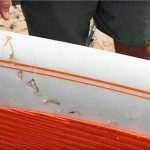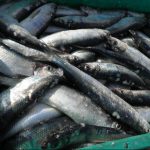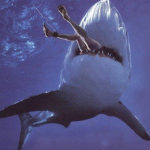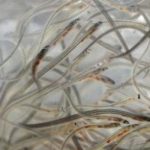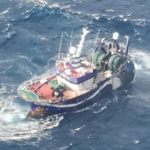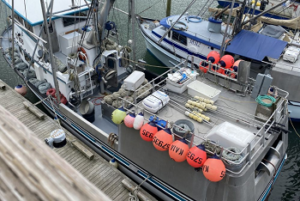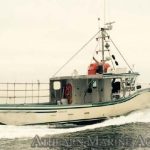Tag Archives: Gulf of Alaska

Expedition breaks new ground in the lives of Pacific salmon
Fisheries scientists have estimated for the first time that 54.5 million Pacific salmon are living in the Gulf of Alaska — providing a valuable new tool to predict how many fish will be returning to B.C. streams to spawn this fall. This new comprehensive count is critical for First Nations, commercial and recreational fishermen, coastal communities, businesses relying on the wild fishery, and fisheries managers trying to figure out why some stocks have declined drastically in certain years or crashed altogether. >click to read<10:40
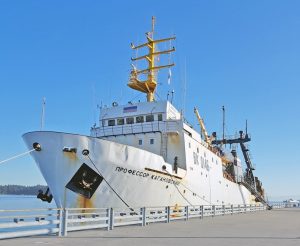
International team of salmon scientists back in port, raring for another mission
The organizer of a month-long Gulf of Alaska salmon survey is already thinking about how to raise money for another trip in the winter of 2020, now that the Russian trawler used in the expedition has finished its job and tied up in Nanaimo. “From what I’ve seen, this needs to be done again,” said Richard Beamish, who came up with the idea of the expedition to mark the International Year of the Salmon with the North Pacific Anadromous Fish Commission. Future surveys would build on data collected by the 21-member volunteer team of international scientists from the five salmon-producing Pacific Rim countries: Canada, Russia, the U.S., Korea and Japan. >click to read<11:52
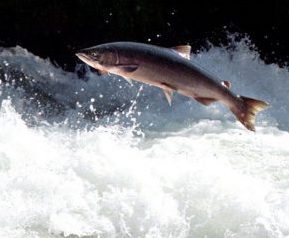
Researchers aim to find where Pacific salmon spend their winters
An international team of scientists is heading to the Gulf of Alaska for a ground-breaking research survey to uncover the secret lives of Pacific salmon in the winter. Discoveries coming out of a 25-day research cruise using a trawler in the North Pacific are expected to help countries do a better job of managing, conserving and restoring salmon stocks, including improving forecasting of returns. “I say it’s the great black box because we basically lose track of the salmon after they leave our coastal waters,” said Brian Riddell, president and chief executive of the Vancouver-based Pacific Salmon Foundation, a key backer of the endeavour. The team is made up of six Canadian scientists, eight from Russia, three from the U.S., and one each from Japan and South Korea.>click to read<13:41
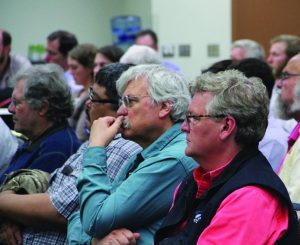
Year in Review: A dismal year for salmon and halibut in the Gulf, Bristol Bay booms, battles over hatcheries
This summer was a disappointment for salmon fishermen across the Gulf of Alaska, both in the timing and in the numbers. Salmon fishermen from Kodiak to Southeast saw poor harvests and poor profits this year due to unexpectedly small runs of sockeye, king and pink salmon. No. 2: Records smashed in Bristol Bay, Norton Sound, No. 3: Hatchery battles at the Board of Fisheries, No. 4: Halibut hardships, falling quotas and prices, >click to read<11:35

One king salmon worth more than a barrel of oil to AK fishermen; Updates for 2018/19
Salmon stakeholders are still crunching the numbers from the 2018 season, which up front has two distinctions: it ranks as one of the most valuable on record to fishermen at nearly $596 million, and at just over 114 million salmon, it’s one of the smallest harvests in 34 years. A breakdown by the McDowell Group shows the sockeye harvest was the second most valuable in 26 years; the chum catch was the third most valuable since 1975. Audio report, >click to read<17:06

Upper Cook Inlet fishermen seek federal disaster declaration
This season was a sour one for salmon fishermen across the Gulf of Alaska, and participants in multiple fisheries are seeking funding for relief. The Board of Fisheries and Gov. Bill Walker already granted a disaster declaration for Chignik, which harvested next to zero sockeye salmon this year due to an unprecedented poor return to the Chignik River on the Alaska Peninsula. Sockeye salmon runs across the Gulf of Alaska failed to deliver this year, either in timing or in size, at a huge cost to fishermen. >click to read<18:17
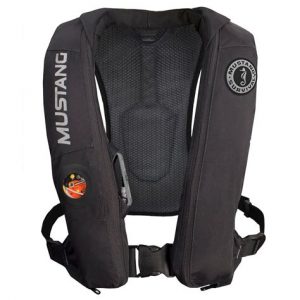
PFD’s – A case for life jackets for all: By Roger R. Locandro
Andre Penton of Fogo Island died June 27 this year in a boating accident on a pond not far from his home in Joe Batt’s Arm. The Fogo Island community mourns his death, with condolences to his wife Rita, his three sons and their families. Although his death was not directly due to drowning, it brought back my own memories of dangers on the water.,, People drown. Don’t take any chances on or around the water. I took chances and almost paid for it with my life. Some years ago, I was commercial seining for salmon in the Gulf of Alaska, out of Cordova. >click to read<22:49

Alaska’s 2018 commercial salmon harvest 30 percent below forecast, yet some fisheries have boomed
The statewide commercial salmon harvest is about 31 percent below the preseason forecast, the Alaska Department of Fish and Game said in a statement Thursday. The 2018 season, it said, “has been unusual.” Preliminary numbers show a statewide commercial salmon harvest of about 103 million fish so far. That’s subject to change, because the fishing season isn’t completely over yet. Fish and Game’s forecast in March projected a total statewide harvest of 147 million fish. >click to read<08:03
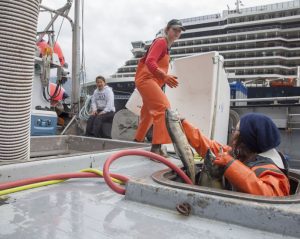
The mysterious case of Alaska’s strange sockeye salmon returns this year
There’s something unusual going on with the sockeye salmon runs returning to Alaska this year. In some places — like Bristol Bay — the runs are strong. In others, like the Copper River or the Kenai River they’re unexpectedly weak. In some places, there are sockeye that are unusually small. In others, sockeye of a certain age appear to be missing entirely. It’s a mystery. In Southeast Alaska, one of the first Fish and Game staffers to notice an unusual trend was Iris Frank, a regional data coordinator and fisheries technician. Frank’s lab is on the first floor of Fish and Game’s Douglas Island office that looks like it hasn’t changed much in the 32 years since she got there. >click to read<18:06
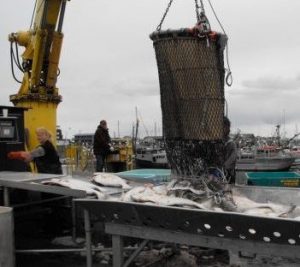
Alaska – Halibut dock prices rebound, but upswing may not last
Halibut prices fell about $2 per pound at the beginning of the season. But there’s good news for some fishermen: ex-vessel prices are increasing slightly around the state. “We did see the ex-vessel price for halibut perk up a bit where we’re at $6.25, $6.50, $6.75 here in Homer today,” said Doug Bowen, who tracks halibut prices around the Gulf of Alaska for Alaska Boats and Permits, a vessel-and-fishing permit broker in Homer. >click to read<16:22
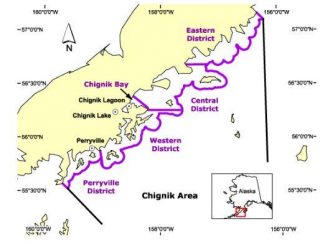
Board of Fisheries declares low Chignik sockeye returns an emergency
Like many Gulf of Alaska communities, far fewer sockeye are returning to the Chignik River than forecasted. Chignik has an early and late run. The combined escapement goal for July 20 is 416,000 sockeye. As of July 18, only 222,000 sockeye had made it upriver to spawn. With no harvestable surplus, the Chignik Management area has not had a commercial fishing opportunity targeting sockeye. Further, some residents say they are voluntarily forgoing subsistence fishing to boost escapement. Audio report, >click to read<13:24
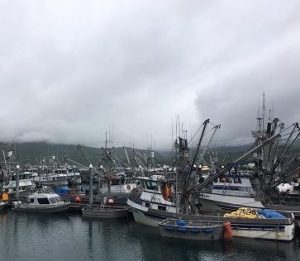
Chignik fishermen stuck ashore as sockeye run fails
Communities around the Gulf of Alaska are struggling with low sockeye returns, and villages near the Chignik River are no different. The region is experiencing its weakest recorded run in the last in 50 years. Fishermen are stuck waiting for a commercial opener,,, There’s really only one thing to talk about in Chignik Bay these days — where are the sockeye? “Shock is pretty much the guaranteed feeling of most people as kinda everybody walking around dazed.” according to Ben Allen, a local fisherman. It’s to the point where residents have pulled their subsistence nets voluntarily to try and get every salmon they can up the Chignik River.,, And, like other nearby communities, red salmon is the main source of income that keeps the lights on in the village. >click to read<18:12
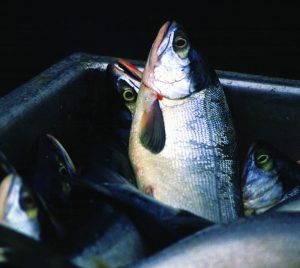
Salmon struggles extend to unprecedented restrictions at Chignik
A tough sockeye salmon commercial fishing season is shaping up in the Gulf of Alaska, from the Copper River across to Kodiak Island and back to the mainland at Chignik. And the Yukon River is seeing dismal chinook salmon returns, although the summer chum run is strong. “I haven’t put my net in the water once,” complained Chignik purse seiner Roger Rowland on June 26. “It’s literally the worst run ever.” Rowland commented from the fishing district on his cellphone, via teleconference in an Unalaska City Council meeting, about 300 miles to the southwest where he lives, during a break between votes. >click to read< 18:36
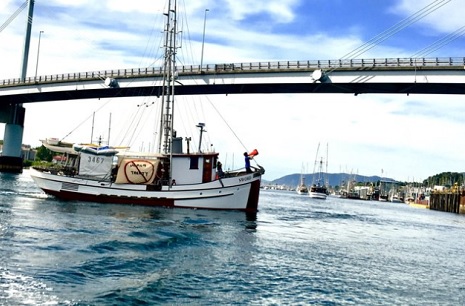
We can’t survive more cuts to Alaska king-salmon quota
Alaska salmon fisherfolk have been giving up a disproportionate portion of their harvest — over 50 percent, at least — to rebuild damaged stocks elsewhere. A few seasons ago in Chatham Strait, Karl Jordan, a third-generation Alaska salmon fisherman, came out to watch as I brought up an ashy-lipped, prismatic monster on the troll gear. Forty-five to 50 pounds. Spots on his tail an inky black. It was the second week of July, the king salmon opener just closed after we had caught our treaty quota. “Looks like a Columbia River hatchery fish,” Karl said. “Let him go.” If Karl was correct — and he usually is when it comes to fishing — that salmon had swum north from Washington’s Columbia River to spend its life in the Gulf of Alaska. >click to read<20:21
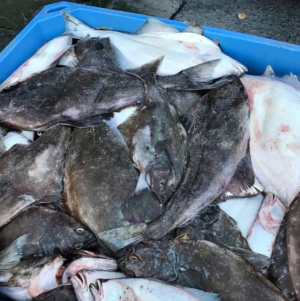
Halibut trash
Only in Alaska, which likes to claim title to the world’s “best-managed fisheries,” would halibut now retailing at prices in excess of $20 per pound be ground into fish meal to feed animals, shrimp and maybe even farmed salmon – the bane of Alaska commercial fishermen. Photos of halibut and other, trawl-caught bottomfish headed for the grinder emerged from Kodiak this weekend as Alaska fishermen started into a fishing season where the targeted harvest of halibut by both commercial fishermen and anglers has been seriously restricted because of conservation concerns. >click to read<18:20
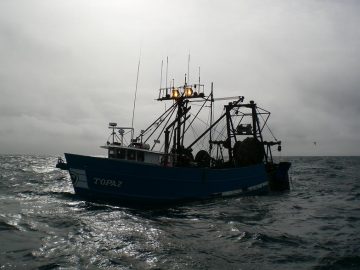
Kodiak Island Borough Assembly support changes to Chinook by-catch limits
King salmon are causing some trouble for Kodiak’s trawl fleet. The problem, too many are being caught as by-catch. The North Pacific Fishery Management Council is currently looking at changing the Chinook prohibited species caps for the Gulf of Alaska for non-pollock catcher vessels in the trawl sector. The purpose of the adjustment would be to reduce the risk of fishery closures. If too many kings are caught in certain commercial fisheries, they’ll be shut down. In 2015, the Pacific cod and flatfish trawl fishery were closed because of this and it cost Kodiak millions >click to read<17:54
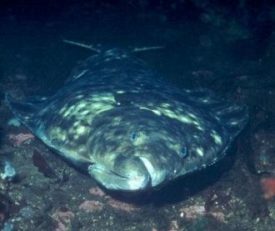
Halibut quotas for 2018 come in slightly lower than expected
The total allowable catch for the 2018 Pacific halibut season in the Gulf of Alaska and Southeast will be set slightly lower than what U.S. commissioners on the International Pacific Halibut Commission had asked for. The National Oceanic and Atmospheric Administration will publish a final rule in the Federal Register Tuesday setting combined charter and commercial quotas in Southeast, area 2C, at 4.4 million pounds. That’s about a 17-percent drop from the total allowable catch in 2017. >click to read<17:39
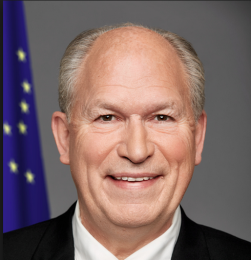
Governor Walker calls for federal disaster declaration for Pacific cod fishery
Gov. Bill Walker and Lt. Gov. Byron Mallott signed a letter last week asking the federal government to declare the 2018 Pacific cod fishery in the Gulf of Alaska a disaster. That could make the fishery eligible for federal relief funds, although who specifically would receive money would be figured out later.,, According to the letter, the value of the 2018 Pacific cod harvest is looking at a more than 80 percent drop in revenue from the five-year average. Barbara Blake, senior adviser to Walker and Mallott, said crossing that 80 percent threshold makes the fishery eligible for a disaster declaration. >click to read< 08:28

UPDATED: Tsunami warnings canceled – 7.9 earthquake in Gulf of Alaska, tsunami warnings issued for coast
An earthquake with a preliminary magnitude of 7.9 hit deep beneath the Gulf of Alaska early Tuesday, and a tsunami warning was issued for coastal areas from British Columbia to the Aleutians. As of 3 a.m. there were no reports of significant waves or damage. The quake was centered 181 miles southeast of Kodiak, according to the Alaska Earthquake Center. The quake was 6 miles deep, the center said. The magnitude was initially reported to be 8.2 but was later downgraded to 7.9. >click here to read< 07:24
Tsunami warnings canceled after magnitude-7.9 earthquake off Alaska – Forecasters canceled tsunami warnings for Alaska and the US and Canadian west coasts Tuesday after an earthquake in the Gulf of Alaska stoked fears of damaging waves. >click here to read< 08:30

Coastal communities to ask for disaster declaration after cod forecast reduced by 80 percent
Kodiak officials already are drafting a disaster declaration due to the crash of cod stocks throughout the Gulf of Alaska. The shortage will hurt many other coastal communities as well. Gulf cod catches for 2018 will drop by 80 percent to just under 29 million pounds in federally managed waters, compared to a harvest this year of nearly 142 million pounds. The crash is expected to continue into 2020 or 2021. Cod catches in the Bering Sea also will decline by 15 percent to 414 million pounds. In all, Alaska produces 12 percent of global cod fish. click here to read the story 12:39 

Kodiak officials prepare for ‘disaster’: An 80 percent decline in Gulf cod catches in 2018
Kodiak officials already are drafting a disaster declaration due to the crash of cod stocks throughout the Gulf of Alaska. The shortage will hurt many other coastal communities as well. Gulf cod catches for 2018 will drop by 80 percent to just under 29 million pounds in federally managed waters, compared to a harvest this year of nearly 142 million pounds. The crash is expected to continue into 2020 or 2021. Cod catches in the Bering Sea also will decline by 15 percent to 414 million pounds. In all, Alaska produces 12 percent of global cod fish. click here to read the story 09:12
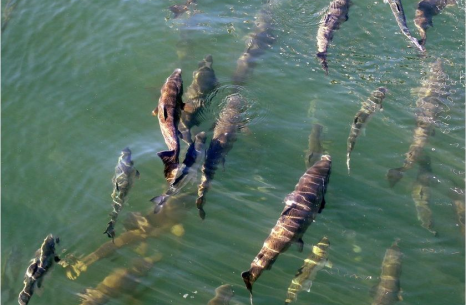
The “blob” is gone, but it’s left a troubling legacy on B.C.’s Pacific coast.
The blob is the popular name for a huge patch of warm water that featured record temperatures — in some cases, three to four degrees Celsius above normal — in the Northeast Pacific starting in 2013 and running through late 2015 and early 2016. Scientists are now concerned that young fish feeding at sea during the blob’s presence did not have enough nutritious food to eat — and that could translate into reduced adult fish to harvest going forward. click here to read the story 08:07
Tanner crab fishery to open in Kodiak for first time since 2013
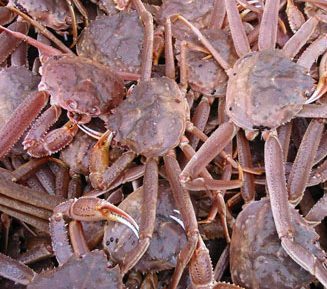 Nat Nichols, Alaska Department of Fish and Game area management biologist for the Groundfish, Shellfish & Dive Fisheries, says the last opening was in 2013. He says ADF & G conducts an extensive trawl survey program between Dutch Harbor and Kodiak focused on tanner crab in the Gulf of Alaska. “This year we did 363 stations. About 200 of those are in Kodiak, so quite a few stations around Kodiak to assess tanner crab abundance.,, Meanwhile, the Dungeness crab season, which opened in May and June, closed last week. click here to read the story 17:35
Nat Nichols, Alaska Department of Fish and Game area management biologist for the Groundfish, Shellfish & Dive Fisheries, says the last opening was in 2013. He says ADF & G conducts an extensive trawl survey program between Dutch Harbor and Kodiak focused on tanner crab in the Gulf of Alaska. “This year we did 363 stations. About 200 of those are in Kodiak, so quite a few stations around Kodiak to assess tanner crab abundance.,, Meanwhile, the Dungeness crab season, which opened in May and June, closed last week. click here to read the story 17:35
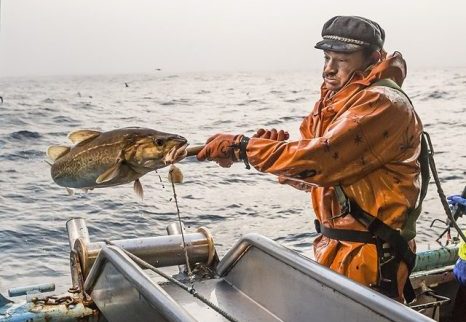
Pacific Ocean ‘blob’ appears to take toll on Alaska cod
Gulf of Alaska cod populations appear to have nose-dived, a collapse fishery scientists believe is linked to warm water temperatures known as “the blob” that peaked in 2015. The decline is expected to substantially reduce the Gulf cod harvests that in recent years have been worth — before processing — more than $50 million to Northwest and Alaska fishermen who catch them with nets, pot traps and baited hooks set along the sea bottom.,,, Scientists don’t ascribe the blob specifically to climate change. Gulf of Alaska temperatures — influenced by atmospheric conditions such as wind strengths — have always fluctuated over time. But researchers have never before tracked such an extreme heat wave that spread across such distances and penetrated to such depths. click here to read the story 11:52
International Pacific Halibut Commission to revisit minimum size limit
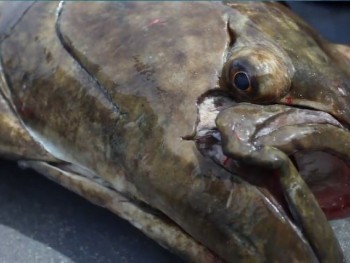 The International Pacific Halibut Commission, which regulates halibut fisheries in U.S. and Canadian waters, is set to take a fresh look at the minimum size limit during its meeting cycle this winter. The current limit allows commercial fishermen to retain fish larger than 32 inches, but the size of mature halibut has been shrinking over the years, which has some wondering whether the limit should be reduced or removed altogether. click here to read the story 09:16
The International Pacific Halibut Commission, which regulates halibut fisheries in U.S. and Canadian waters, is set to take a fresh look at the minimum size limit during its meeting cycle this winter. The current limit allows commercial fishermen to retain fish larger than 32 inches, but the size of mature halibut has been shrinking over the years, which has some wondering whether the limit should be reduced or removed altogether. click here to read the story 09:16
We’re On Board with These Two Fishermen – Salmon Fishing Season Starts Today
 Our town of Cordova, Alaska is humming with the sounds of diesel engines firing up, big trucks hurrying around the harbor and fishermen catching up with each across the docks. This week holds so much excitement and anticipation here. Today, May 18th, the fleet of 540 fishermen from this tiny coastal community take off for the Gulf of Alaska where we’ll be setting our nets to catch the first wild salmon making their way back to the Copper River. The Alaska Department of Fish and Game carefully monitors our fishery for long term sustainability and have designated the salmon season to start this week with a 12 hour commercial fishing period starting bright and early at 7 am on Thursday. Click here to read the story 07:42
Our town of Cordova, Alaska is humming with the sounds of diesel engines firing up, big trucks hurrying around the harbor and fishermen catching up with each across the docks. This week holds so much excitement and anticipation here. Today, May 18th, the fleet of 540 fishermen from this tiny coastal community take off for the Gulf of Alaska where we’ll be setting our nets to catch the first wild salmon making their way back to the Copper River. The Alaska Department of Fish and Game carefully monitors our fishery for long term sustainability and have designated the salmon season to start this week with a 12 hour commercial fishing period starting bright and early at 7 am on Thursday. Click here to read the story 07:42
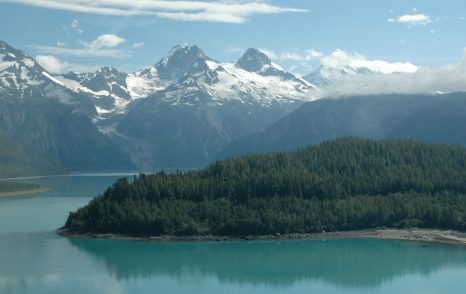
Where Is America’s Next War? Alaska. And the enemy is not who you’d expect.
It’s war in the Gulf and the US Navy is on hand to protect us. No, not that Gulf! I’m talking about the Gulf of Alaska and it’s actually mock war — if, that is, you don’t happen to be a fin whale or a wild salmon. This May, the Navy will again sail its warships into the Gulf of Alaska. There, they will engage in military maneuvers and possibly drop bombs, launch torpedoes and missiles, and engage in activities that stand a significant chance of poisoning those once-pristine waters, while it prepares for future battles elsewhere on the planet. Think of it as a war against wildlife, an assault on the environment and local coastal communities. click here to continue reading the article 11:57


































